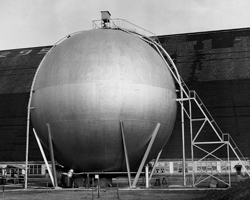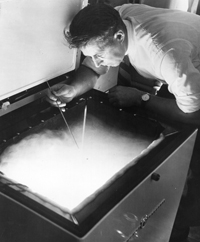Physics of the Atomosphere
Photos of the Month — June 2014
In honor of AIP's newest Member Society, the American Meteorological Society, we feature atmospheric physics. Researchers in the field have utilized such intriguing scientific equipment as sounding rockets, weather balloons, and a cloud chamber that can produce "man-made snow." It was Benjamin Franklin who proposed and later conducted the first kite experiment, trying to understand the mysterious ways of lightning and atmospheric electricity. Later, scientists would begin expeditions as far as Antarctica to gain insights into atmosphere and climate conditions. An expedition on conducting upper atmosphere water vapor studies under the sponsorship of the National Science Foundation is highlighted in this month's collection. To see more images like the ones we've selected, type the word “Meteorology” in the search engine.

Abraham Schnapf, Manager of Program Management at RCA's Astro - Electronics Division, Princeton, New Jersey is shown with the first TIROS weather satellite. Circa 1960. RCA News and Information, courtesy AIP Emilio Segrè Visual Archives, Physics Today Collection.

A 3,000 cubic meter cloud chamber for Weather Bureau research. The object is to bring cloud and weather processes into the laboratory where quantitative control of conditions can be maintained. Used in a number of investigations on precipitation mechanics. Compressor and washer in background. Airlock and 20 inch access pipe and valve in left foreground. Small laboratory underground. Droplet growth and evaporation studies can be made by dropping droplets of controlled size from top to bottom and measuring the change in falling velocity by electronic means. February 6, 1962. Credit: AIP Emilio Segrè Visual Archives.

John A. Brown helps Emmett J. Pybus as they release a balloon on a calm day in the Antarctic. The two men from the Ballistic Research Laboratories at Aberdeen proving Ground, MD, conducted upper atmosphere water vapor studies under the sponsorship of the National Science Foundation. Circa 1961. AIP Emilio Segrè Visual Archives, Physics Today Collection.

Illustration from Benjamin Franklin's 'Experiments and Observations on Electricity,' Paris circa 1752 (AIP rare books collection). [Excerpt from 'HISTORY OF PHYSICS,' Weart and Phillips, p. 16: Franklin's most persuasive demonstration (Fig. II) of the qualitative difference between the electrifications of the two coatings of a Leyden jar [the general subject of this page of illustrations] (Fig. VIII): his analysis of the binding of electrical atmospheres postulates and attractive force between electrical and common matter. (Fig. IX): the sentry box illustrates his design for bringing down lightning from the clouds.] 1752. Credit: 'Experiments and Observations on Electricity' by Benjamin Franklin, Paris, circa 1752, courtesy AIP Emilio Segrè Visual Archives.

Man-made snow has been created for first time by Vincent Schaefer at the General Electric Research Laboratory. Here Dr. Schaefer waves his scientific wand through snow cloud produced in a cold chamber. Cloud was created by introducing moist air from the breath into minus 5 degrees fahrenheit temperature of atmosphere in the chamber. The wand, cooled in liquid air to minus 70 degrees fahrenheit, leaves tiny ice germs in the cloud which grow at expense of water droplets comprising the cloud. Result: man-made snow. November 29, 1946. Credit: AIP Emilio Segrè Visual Archives, Physics Today Collection.

L–R: Jule Charney, Norman Phillips, Glenn Lewis, N. Gilbarg, and George Platzman pose for photograph. They are some of the members of the Meteorology Project at the Institute for Advanced Study. The IAS computer, MANIAC 1, is in the background. 1952. Credit: Photograph by Joseph Smagorinsky, courtesy AIP Emilio Segrè Visual Archives, gift of John M. Lewis.
